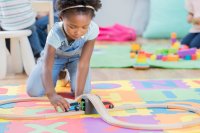Key Aspects of Play in Early Education
Some important considerations for integrating play in early childhood learning environments.
With the publication of the American Academy of Pediatrics’ recent report The Power of Play, early childhood educators may be more eager to include play in young children’s experiences due to its cognitive and social and emotional benefits. While the report targets pediatricians, it provides research about how play benefits children’s learning, peer engagement, physical growth, and health, and offers insight into how play can be integrated into early childhood programs.
The report has encouraged me reflect on foundational points that guide my approach to play in early childhood. My education, experiences with young children, and upbringing in a family of teachers have influenced how I view play as a way for children build and show their understanding and knowledge of their world. For example, though I had toys, I was also encouraged to use some household items creatively—like making a “home” out of cardboard boxes with my cousins—and I pretended to be one of the X-Men with my siblings and cousins after watching the animated series.
These foundational experiences have allowed me to grasp the significant role of play in children’s upbringing and were a resource for me as I learned about the significance of play in my graduate program and my experiences with young children. At the same time, my education and experiences have also helped me understand that play is dynamic and looks different in different circumstances—there’s no single right way to play.
Ideas for Integrating Play in Early Education
There are several key aspects of play that ground my thinking on play in early childhood education.
Recognize your lens of play. As educators, our beliefs and values play a role in the type of educational environment we foster, and our experiences and culture influence how we think about play and how we nurture play in our classroom setting.
These factors influence a range of choices we make: whether we designate areas for play, how children interact and communicate, and the materials and choices we make available to children. For instance, a teacher may see play as belonging on the playground during recess or as an essential component to children’s learning.
I see play as a valuable experience for children starting in the early years and progressing to later ages. This perspective was largely influenced by Vivian Paley, who has noted that fantasy and dramatic play are “the glue that binds together all other pursuits,” contributing to children’s academic learning, artistic interests, and social development, as well as providing a way for children to process their understanding of the world.
These forms of play can occur in many different areas of an early childhood setting—the block area, sensory stations, or a specific area set up for dramatic play. The idea is that while children do play on the playground, it’s also beneficial when play occurs throughout the day at other times in the program.
Resist the urge to do play one way. What play looks like will differ among children and their communities. Children may be accustomed to pretending to be superheroes, reenacting everyday scenarios, or playing through games or jokes. Additionally, children may embed elements of their culture in their play, revealing family beliefs and aspects of the language spoken at home or within their cultural community.
Children’s playmates vary by culture and may include parents and other family members of different ages, and peers their age. Therefore, some children may be inclined to play with educators, seeing them as collaborators in the experience, while others may not. Children may interact with us in different ways than we are accustomed to.
Taking into account the role of culture in play has helped me become open-minded to seeing how play manifests in children as well as how families view play. It also helped me think about the play experiences I offer—child-initiated, adult-facilitated, etc. By noticing these details, I’m able to create spaces that are more supportive of varieties of play; I may have children recreate roles from a story, or set up an area as a restaurant or hospital to foster dramatic and sociodramatic play with props, or make a game station with board and card games.
Have a variety of materials to support children’s play. Having diverse play materials will help enrich your environment. Stories from books can be used to encourage play during center time, and placing combinations of different objects throughout the room can stimulate children’s creativity. Offering a range of materials—a variety of shapes and sizes of blocks, dolls and hand puppets, items from nature—increases the potential of exposing children to things they haven’t experienced before.
It’s also important to consider how all children in the setting can access these materials—ensuring that they’re visible, reachable, and identifiable for all learners creates a supportive and inclusive environment.
I still have experiences where the children’s familial or cultural attitudes about play conflict with my beliefs and approach, and occasions when colleagues and I differ in perspective. This is where communication becomes essential—we just need to remember that we’re all trying to do our best to support the children.
Having clarity about who I am as an educator and researcher and an understanding of concepts that ground my thinking helps me make intentional choices about play and its integration so that I’m both supporting children’s growth and being aware there’s no one-size-fits-all approach to play.
